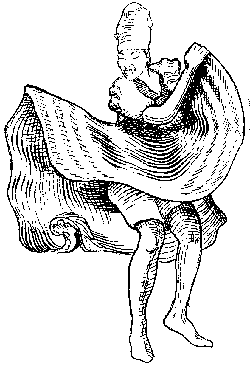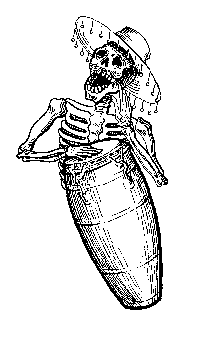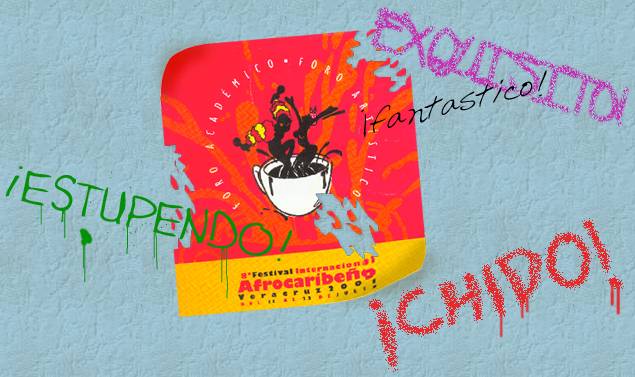REPORT
FROM
THE
2001 FESTIVAL
 The
Veracruz Institute of Cultures (IVEC) has organized the International
Afrocaribbean Festival for the last 8 years "with the idea of promoting
and spreading, through the artistic and academic richness of the Caribbean,
the diverse cultural manifestations that have come as a result of the
mixing of mestizo (Native American-European) and African races. From this
mixture has been born the Afrocaribbean culture." The
Veracruz Institute of Cultures (IVEC) has organized the International
Afrocaribbean Festival for the last 8 years "with the idea of promoting
and spreading, through the artistic and academic richness of the Caribbean,
the diverse cultural manifestations that have come as a result of the
mixing of mestizo (Native American-European) and African races. From this
mixture has been born the Afrocaribbean culture."

 The festival is comprised
of academic, artistic and musical presentations. In past years the themes
for the academic conferences have been subjects such as tobacco and sugar
cane. In 2001 the theme was coffee. Academic investigators, writers, coffee
growers and NGO organizations came together to discuss aspects of this
theme. The festival is comprised
of academic, artistic and musical presentations. In past years the themes
for the academic conferences have been subjects such as tobacco and sugar
cane. In 2001 the theme was coffee. Academic investigators, writers, coffee
growers and NGO organizations came together to discuss aspects of this
theme.

 Musically
the festival brings together musicians from all
over the Caribbean and beyond for 11 evenings of excellent concerts and
presentations. The concert mainstage is on the malecon, or harbor boulevard
of Veracruz. The bay and ancient Spanish fortress of San Juan backs the
stage. Each evening from about 7:30 to 12:30 band after band gives its
best to the audience. There is ample room to dance for those who are moved
to their feet. There are additional concerts presented in neighborhood
parks around the city. In 2001 a block in old town was closed off and
the Estrellas Cubanas played classic Cuban dance tunes until 3AM and there
were two concerts presented on Iguanas Beach. In past years IVEC has also
offered short workshops with dancers and percussionists from the festival.
They promise to do it again this year, probably featuring Colombian percussion. Musically
the festival brings together musicians from all
over the Caribbean and beyond for 11 evenings of excellent concerts and
presentations. The concert mainstage is on the malecon, or harbor boulevard
of Veracruz. The bay and ancient Spanish fortress of San Juan backs the
stage. Each evening from about 7:30 to 12:30 band after band gives its
best to the audience. There is ample room to dance for those who are moved
to their feet. There are additional concerts presented in neighborhood
parks around the city. In 2001 a block in old town was closed off and
the Estrellas Cubanas played classic Cuban dance tunes until 3AM and there
were two concerts presented on Iguanas Beach. In past years IVEC has also
offered short workshops with dancers and percussionists from the festival.
They promise to do it again this year, probably featuring Colombian percussion.

 At the
moment, IVEC has not put up information about this year's upcoming festival.
But check into their webpage
periodically, as sooner or later they'll post the festival info. Last
year it was later, about 5 days before the festival. We are working with
them this year to get the info up sooner. At the
moment, IVEC has not put up information about this year's upcoming festival.
But check into their webpage
periodically, as sooner or later they'll post the festival info. Last
year it was later, about 5 days before the festival. We are working with
them this year to get the info up sooner.

 Take a look at these newspaper
articles for a bit on last year's festival. From Cuba, in English, Granma
Internacional, and from Mexico, in Spanish, La
Jornada. See below for last years performance schedule. Take a look at these newspaper
articles for a bit on last year's festival. From Cuba, in English, Granma
Internacional, and from Mexico, in Spanish, La
Jornada. See below for last years performance schedule.
Schedule: Afrocaribbean Festival
July 2001
 Wednesday
11 Wednesday
11
Festival Inauguration
Paseo del Malecon 8pm
Participants: Ruben Blades (Panama), William Cepeda (Puerto Rico)

Friday 13
Africa, America program
Paseo del Malecon, 8pm
Participants: Chuchumbe (Mexico), Vieux Diop (Senegal) and Sista Monica
(USA)

Saturday 14
Neighborhood Festival Program
Las Brisas Recreation Center 6pm
Particpants: Tamborileros de Nacajuca (Tabasco-Mex), Big Band Jazz and
Sol Mestizo (Xalapa-Mex)

Bugambilia Park, 6pm
Participants: Quetzal (USA), Son como Son (Veracruz-Mex)

Afrocuban Night program
Paseo del Malecon, 8pm Participants: Obini Ana (Xalapa-Mex), Yoruba Andaba
(Cuba), Estrellas Cubanas and Juana Bacallo (Cuba).

Block Party and Dance Ataranzas Street, 10:30
Participants: Estrellas Cubanas (Cuba) and Hjalmar y su Orquestra (Colombia-Mexico)

Sunday 15

Neighborhood Festival Program
Las Brisas Recreation Center 6pm Particpants: Quetzal (USA)

Bugambilia Park, 6pm
Participants: Tamborileros de Nacajuca (Tabasco-Méx) Chuchumbé (Veracruz-Méx)
and Vieux Diop (Senegal)

All Roads Program
Paseo del Malecon, 8pm Participants: Big Band Jazz (Xalapa-Méx), Sol Mestizo
(Xalapa-Méx), Quetzal (USA) y Rodolfo 'Popo' Sánchez (Méx)

Drumers Program
Playa Iguanas, 10:30
Gathering of drums Particpants: Tamborileros de Nacajuca (Tabasco- Méx),
Tambores Barloventeños (Venezuela), Yoruba Andabo (Cuba) and Olodum (Brasil)

Tuesday 17
presentacion
City Square, 8pm Capoeíra Longe do Mar (Brasil)

Wednesday 18
Theatre Teatro de la Reforma, 8pm
Teatro Negro de Barlovento (Venezuela)

Thursday 19
Theatre Teatro de la Reforma, 8pm
Teatro Negro de Barlovento (Venezuela)

A night in Macondo Program
Paseo del Malecón, 8pm
Participants: Estampas Colombianas, Así es el Llano (Colombia), William
Cepeda and Afro-Rican jazz (Puerto Rico), David Haro, Armando Chacha (México)

Friday 20
Africa Here! Program
Paseo del Malecón, 8pm
Participants: SEC percussion ensable (Xalapa-Mex), Sol Mestizo y Grupo
Folklorico (Veracruz-Mex) and Tania Libertad (Perú) Paseo del Malecón
20:00 hora

Saturday 21
Neighborhood Festival Program
Las Brisas Recreation Center 6pm Particpants: Yoruba Andabo (Cuba), Karachi
y Piel Morena (Cuba)

Bugambilia Park, 6pm
Participants: La Negra Graciana (Ver-Mex) and Estrellas Cubanas (Cuba)

Cuban stars in Mexico program
Paseo del Malecon, 8pm
Participans: Victor Lay and Son de Luna (Cuba-Mex), Osmany Paredes (Cuba),
Ricardo Benitez (Cuba) and El Gran Fellove (Cuba)

Sunday 22
Neighborhood Festival Program
Las Brisas Recreation Center 6pm Particpants: Yoruba Andabo (Cuba)

Bugambilia Park, 6pm
Participants: Juana Bacallo (Cuba)

The Mexican Sound Program
Paseo del Malecon, 8pm Participants: Pregoneros del Recuerdo (Veracruz-Mex),
Son de la Loma (Veracruz-Mex), La Mata del Son (Mexico City-Mex)

Beach Bash
Iguanas Beach, 10:30
Participants:
La Tremenda Korte (Mex), Merenglass (Dom Rep.), Senor Bikini (Mex)

HOME

 Performers:
Afrocaribbean Festival Performers:
Afrocaribbean Festival
July 2001

Ruben
Blades.
Panama. Helped bring salsa to the world. Has played with other
greats such a Ray Barreto and Willie Colon. Composed Pedro Navajas, won
a grammy with his group, Sies del Solar.

Oscar
Chavez. Mexico. Singer, songwriter, folklorist,
social activist.

Longe do Mar. Brazil. Performers of capoeira- a form of
self defense developed by Brazilian slaves whose defensive elements are
hidden in the movements of dance.

Murah
Soares. Brazil. The Brazilian religion of candombol is
celebrated thought vigorous afro-Brazilian dances. Murah Soares, also
trained in ballet and modern dance, is a virtuoso when dancing candombole.

Olodum.
Brazil. Natives of Bahia, Olodum has played with Gal Costa, Jimmy
Cliff and Paul Simon. Olodum expresses the energy and feelings of the
black Bahia community through the rhythms of rap, reggae and sambe-reggae.

Yoruba Andabo, Cuba. From Havana.,16 singers, percussionists and
dancers who perform Cuban rumba with Yoruba songs and dances to the Orishas.
Mesmerizing rhythms, amazing movement!

Osmany Paredes Gonzalez. Cuba. From a long line of Cuban musicians,
Osmany has performed with Orquestra America, Israel "Cachao" Lopez, Celio
Gonzalez and Amaury Gutierrez.

Victor
Lay. Cuba. Founder of the Orquestra Aragon and composer
of Cien Fuegos Tiene su Guaguanco, this singer/songwriter has been an
important figure in Cuban music for 60 years.

Son de Luna. Mexico. These young musicians from Sonora bring to
us the rhythms of son montuno, rumba, cha-cha-cha, mambo and danzon. They
have played in Mexico, Cuba and the USA.

La Mata del Son. Mexico. This group brings together the flavor
Cuban son and elements of Mexican traditional music. They are currently
producing and album with sons, boleros and rumbas. La Mata del Son has
performed in Mexico, Venezuela, Austria and Germany.

Teatro Negro de Barlovento. Venezuela. For 25 years Teatro Negro
has brought to the stage through music, dance, poetry and performance
the cultural values of the coastal region of Venezuela in Miranda state.
Their goal is to conserve and spread the Afro-Venezuelan culture. They
also run programs aimed at bettering the quality of life in this region.

William Cepeda.
Puerto Rico. This superb trombonist has been inspired by the traditional
rhythms of Puerto Rico, the bomba and plena. He has combined this with
Jazz to create Afrorican Jazz.

Sista Monica. USA. With roots in Chicago gospel, Sista Monica has
been called "The best new blues band", has played the Monterey Blues Festival,
and has played in Holland, Belgium and Norway.

Quetzal. USA. Compared with Los Lobos and at the forefront of the
LA Chicano Artisitic movement, this band combines son Jarocho, Son Montuno,
Cumbia, Jazz, rock and blues to create strong, rich music with a message
about community and roots.

Estampas Colombianas. Mexico-Colombia. This folkloric group was
created in 1982 in Mexico city to create a voice to express and share
Colombian culture through music, dance and poetry.

La Tremenda
Korte. Mexico. This group of young musicians creates energetic
dance music to the rhythm of ska. Their first disc was called "the best
debut of Afrolatin rock" by the magazine Nuestro Rock.

La Negra Graciana. Mexico. A virtuoso harpist from central Veracruz
state who plays the lively and fast rhythms of son Jarocho, a musical
style born of the combination of African and Spanish musical traditions.
Internationally, the best known song from this genre is La Bamba.

Tania Libertad. Peru. Interprets boleros, rumbas, folkloric and
popular Latin American songs.

Orquestra de Musica Traditional Moscovita. Mexico. Playing rhythms
like danzon, bolero, cha-cha-cha, son, pregon and mambos, this orchestra's
focus is Afrocaribbean music and traditional music of Veracruz.

Combo Ninguno. Mexico. From the city of Xalapa, danceable Caribbean
rhythms are at the core of this bands lively sound.

Sol Mestizo. Mexico. Born as part of investigations of African
customs in a small village in Veracruz state, Coyolillo, this group presents
rhythms and dances brought to the Americas by African slaves.

Obini Ana. Mexico. A female percussion trio with a focus on West
African and Afrocaribbean rhythms.

Merenglass. Dominican
Republic. With musicians from the Dominican Republic and Mexico, Merenglass
brings together a fusion D.R. and Mexican sound to their very danceable
merengue.

Vieux
Diop. Senegal. East African musician and singer who crosses the
bridge between traditional and modern with his music.

Chuchumbe.
Mexico. Plays the son Jarocho fandango music of southern Veracruz
as well as investigating and reviving ancient songs and dances from the
region. Together with Vieux Diop they create an enchanting African-Mexican
sound.

Hjalmar el Mayor. Colombia-Mexico. The flavor of Colombia with
merengue, Vallenato, salsa and son rhythms.









|
